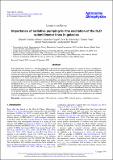Por favor, use este identificador para citar o enlazar a este item:
http://hdl.handle.net/10261/305367COMPARTIR / EXPORTAR:
 SHARE SHARE
 CORE
BASE CORE
BASE
|
|
| Visualizar otros formatos: MARC | Dublin Core | RDF | ORE | MODS | METS | DIDL | DATACITE | |

| Título: | The importance of radiative pumping on the emission of the H_2O submillimeter lines in galaxies |
Autor: | González-Alfonso, Eduardo; Fischer, Jacqueline; Goicoechea, Javier R. CSIC ORCID; Yang, Chentao; Pereira-Santaella, Miguel CSIC ORCID; Stewart,Kenneth P. | Palabras clave: | Galaxies: ISM Infrared: galaxies ISM: Molecules Line: Formation Radiative transfer Submillimeter: Galaxies; astro-ph.GA; astro-ph.GA |
Fecha de publicación: | 14-sep-2022 | Editor: | EDP Sciences | Citación: | Astronomy & Astrophysics 666: L3 (2022) | Resumen: | H_2O submillimeter emission is a powerful diagnostic of the molecular interstellar medium in a variety of sources, including low- and high-mass star forming regions of the Milky Way, and from local to high redshift galaxies. However, the excitation mechanism of these lines in galaxies has been debated, preventing a basic consensus on the physical information that H_2O provides. Both radiative pumping due to H_2O absorption of far-infrared photons emitted by dust and collisional excitation in dense shocked gas have been proposed to explain the H_2O emission. Here we propose two basic diagnostics to distinguish between the two mechanisms: 1) in shock excited regions, the ortho-H_2O 3_{21}-2_{12} 75um and the para-H_2O 2_{20}-1_{11} 101um rotational lines are expected to be in emission while, if radiative pumping dominates, both far-infrared lines are expected to be in absorption; 2) based on statistical equilibrium of H_2O level populations, the radiative pumping scenario predicts that the apparent isotropic net rate of far-infrared absorption in the 3_{21}-2_{12} (75um) and 2_{20}-1_{11} (101um) lines should be higher than or equal to the apparent isotropic net rate of submillimeter emission in the 3_{21}-3_{12} (1163 GHz) and 2_20-2_{11} (1229 GHz) lines, respectively. Applying both criteria to all 16 galaxies and several galactic high-mass star-forming regions where the H_2O 75um and submillimeter lines have been observed with Herschel/PACS and SPIRE, we show that in most (extra)galactic sources the H_2O submillimeter line excitation is dominated by far-infrared pumping, with collisional excitation of the low-excitation levels in some of them. Based on this finding, we revisit the interpretation of the correlation between the luminosity of the H_2O 988 GHz line and the source luminosity in the combined galactic and extragalactic sample. | Descripción: | 9 pags., 5 figs. | Versión del editor: | https://doi.org/10.1051/0004-6361/202244700 | URI: | http://hdl.handle.net/10261/305367 | DOI: | 10.1051/0004-6361/202244700 | ISSN: | 0004-6361 |
| Aparece en las colecciones: | (CFMAC-IFF) Artículos |
Ficheros en este ítem:
| Fichero | Descripción | Tamaño | Formato | |
|---|---|---|---|---|
| radiative_pumping.pdf | Artículo principal | 830 kB | Adobe PDF |  Visualizar/Abrir |
CORE Recommender
SCOPUSTM
Citations
7
checked on 19-may-2024
WEB OF SCIENCETM
Citations
7
checked on 22-feb-2024
Page view(s)
16
checked on 20-may-2024
Download(s)
7
checked on 20-may-2024
Google ScholarTM
Check
Altmetric
Altmetric
Este item está licenciado bajo una Licencia Creative Commons

